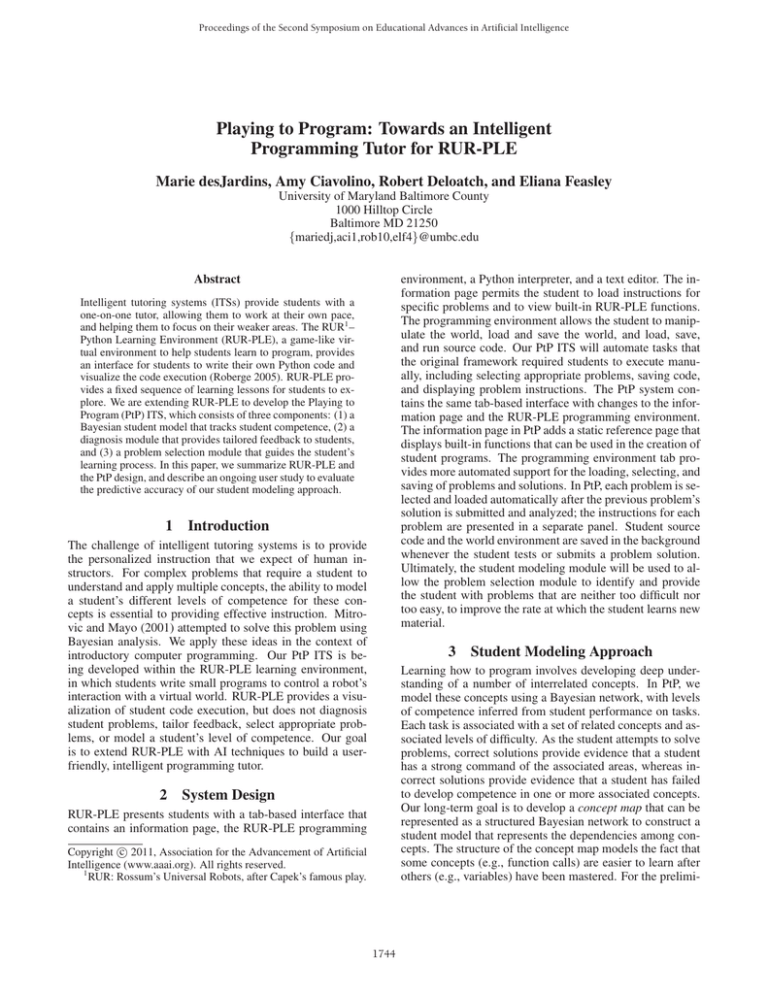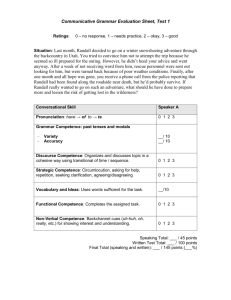
Proceedings of the Second Symposium on Educational Advances in Artificial Intelligence
Playing to Program: Towards an Intelligent
Programming Tutor for RUR-PLE
Marie desJardins, Amy Ciavolino, Robert Deloatch, and Eliana Feasley
University of Maryland Baltimore County
1000 Hilltop Circle
Baltimore MD 21250
{mariedj,aci1,rob10,elf4}@umbc.edu
environment, a Python interpreter, and a text editor. The information page permits the student to load instructions for
specific problems and to view built-in RUR-PLE functions.
The programming environment allows the student to manipulate the world, load and save the world, and load, save,
and run source code. Our PtP ITS will automate tasks that
the original framework required students to execute manually, including selecting appropriate problems, saving code,
and displaying problem instructions. The PtP system contains the same tab-based interface with changes to the information page and the RUR-PLE programming environment.
The information page in PtP adds a static reference page that
displays built-in functions that can be used in the creation of
student programs. The programming environment tab provides more automated support for the loading, selecting, and
saving of problems and solutions. In PtP, each problem is selected and loaded automatically after the previous problem’s
solution is submitted and analyzed; the instructions for each
problem are presented in a separate panel. Student source
code and the world environment are saved in the background
whenever the student tests or submits a problem solution.
Ultimately, the student modeling module will be used to allow the problem selection module to identify and provide
the student with problems that are neither too difficult nor
too easy, to improve the rate at which the student learns new
material.
Abstract
Intelligent tutoring systems (ITSs) provide students with a
one-on-one tutor, allowing them to work at their own pace,
and helping them to focus on their weaker areas. The RUR1 –
Python Learning Environment (RUR-PLE), a game-like virtual environment to help students learn to program, provides
an interface for students to write their own Python code and
visualize the code execution (Roberge 2005). RUR-PLE provides a fixed sequence of learning lessons for students to explore. We are extending RUR-PLE to develop the Playing to
Program (PtP) ITS, which consists of three components: (1) a
Bayesian student model that tracks student competence, (2) a
diagnosis module that provides tailored feedback to students,
and (3) a problem selection module that guides the student’s
learning process. In this paper, we summarize RUR-PLE and
the PtP design, and describe an ongoing user study to evaluate
the predictive accuracy of our student modeling approach.
1
Introduction
The challenge of intelligent tutoring systems is to provide
the personalized instruction that we expect of human instructors. For complex problems that require a student to
understand and apply multiple concepts, the ability to model
a student’s different levels of competence for these concepts is essential to providing effective instruction. Mitrovic and Mayo (2001) attempted to solve this problem using
Bayesian analysis. We apply these ideas in the context of
introductory computer programming. Our PtP ITS is being developed within the RUR-PLE learning environment,
in which students write small programs to control a robot’s
interaction with a virtual world. RUR-PLE provides a visualization of student code execution, but does not diagnosis
student problems, tailor feedback, select appropriate problems, or model a student’s level of competence. Our goal
is to extend RUR-PLE with AI techniques to build a userfriendly, intelligent programming tutor.
2
3
Student Modeling Approach
Learning how to program involves developing deep understanding of a number of interrelated concepts. In PtP, we
model these concepts using a Bayesian network, with levels
of competence inferred from student performance on tasks.
Each task is associated with a set of related concepts and associated levels of difficulty. As the student attempts to solve
problems, correct solutions provide evidence that a student
has a strong command of the associated areas, whereas incorrect solutions provide evidence that a student has failed
to develop competence in one or more associated concepts.
Our long-term goal is to develop a concept map that can be
represented as a structured Bayesian network to construct a
student model that represents the dependencies among concepts. The structure of the concept map models the fact that
some concepts (e.g., function calls) are easier to learn after
others (e.g., variables) have been mastered. For the prelimi-
System Design
RUR-PLE presents students with a tab-based interface that
contains an information page, the RUR-PLE programming
c 2011, Association for the Advancement of Artificial
Copyright Intelligence (www.aaai.org). All rights reserved.
1
RUR: Rossum’s Universal Robots, after Capek’s famous play.
1744
nary user study we describe below, we have implemented a
simple version of the Bayesian student model, using a naive
Bayes model that treats the concepts as being independent.
(The design of the user study actually does not depend on the
representation of the student model, so we will later be able
to expand the model to a richer representation and re-analyze
the data using this expanded model.) The student model is a
generative model: that is, it describes the expected behavior
of a student, given a known level of understanding. For each
concept, a student’s ability to correctly solve a problem using that concept depends probabilistically on two factors: (1)
their level of understanding for the concept and (2) the degree of difficulty with which that concept is expressed in the
problem. We model students as having competence in each
concept at one of four possible levels of understanding: no
competence, very little competence, moderate competence,
or full competence. For each concept in each problem, we
model the prior probability that the student will answer the
the problem correctly as a function of the student’s competence of the concept and the difficulty of the problem. Even
a student who is highly competent in a concept might answer a problem involving that concept incorrectly for a variety of reasons, including an incorrect interpretation of the
problem or a lack of competence in another concept that is
required to produce a successful solution. For problems that
include multiple concepts, the naive Bayes student model
give the probability that the student will answer the problem
correctly as the product of the probabilities that they would
answer a questions containing each concept individually.
4
using a set of programming problems that are both more
complex and more open-ended than the pretest questions.
Like the pretest questions, they incorporate multiple concepts at different levels of difficulty. The student modeling module will use these levels of difficulty, in conjunction
with the learned model of the particular student, to predict
which questions are likely to be answered correctly. Two
metrics of predictive accuracy will be considered: simple accuracy (reducing the probabilistic predictions to yes (greater
than 50%)/no (less than 50%) and weighted accuracy (mean
squared loss of the predicted probabilities, where a correct
answer is treated as 1.0 and an incorrect answer is treated as
0.0). We will also compare the predictive accuracy of student performance on these open-ended problems to that of
a control group who answered a set of program-prediction
questions. Twenty participants (3 female, 17 male) were
recruited for the study. Participants were UMBC students
who have completed at least one computer science major
class but have not completed any computer science classes
designed for juniors or seniors. The scores on the diagnostic warm-up ranged from 14 - 86 percent (μ = 68.5). The
scores on the pre and post-tests ranged from 36 - 100 percent
(μ = 77). We gathered demographic information (age, sex,
programming classes completed and grades in those classes,
etc.) in order to analyze the effect of these characteristics on
student performance. The pretest and the problems solved
are available at our repository (UMBC MAPLE Laboratory
2011). We are currently in the data analysis phase of the user
study.
Experimental Design
5
We have designed a user study to evaluate the accuracy of
our Bayesian model by measuring the accuracy of predictions about student performance on real, challenging problems, based on observed student performance on simpler
“warmup”, “pretest”, and “posttest” problems. These problems are designed to evaluate student competence in each of
various concepts. In all, there are 44 multiple-choice and
short-answer questions, each of which assesses student understanding of specific individual concepts, with a difficulty
level associated with each concept for each problem. In the
current design, the concepts are limited to a few basic programming concepts: loops, function calls, conditionals, and
variables. We will use the Bayesian student model to update the student’s most likely level of competence for each
concept, given which questions they answer correctly and
incorrectly. The questions require the student to perform
a range of tasks, including predictive questions (identifying what outcome or error will occur when the program attempts to execute a snippet of code), completion questions
(filling in code to complete a simple algorithm), and recognition questions (determining which of several short programs
will successfully accomplish a given task). These problems
are designed to test both individual concepts in isolation and
multiple concepts in combination. While the pretest questions are useful for measuring student competence in concepts, the goal of the tutoring is to ensure that students are
able to write their own programs from scratch. We use the
pretest to create a student model, and then test this model
Conclusions and Future Work
A useful intelligent tutor must not only predict which problems students are expected to answer correctly, but also use
these predictions to provide students with a higher-quality
learning experience. We plan to integrate our system with
an interactive process to continually provide students with
more challenging but still appropriate problem sets. This
problem selection will leverage the Bayesian student model
that uses our proposed structured concept map. Additional
future work includes creating a diagnostic module so that instead of merely evaluating whether a problem was answered
correctly, we can attempt to evaluate where a student went
wrong at a more fine-grained level (e.g., a conceptual misunderstanding, a syntactic error, or incorrect boundary condition checking). This improved diagnosis will aid in student
modeling and problem selection.
References
Mitrovic, A., and Mayo, M. 2001. Optimising ITS behaviour with Bayesian networks and decision theory. International Journal of Artificial Intelligence in Education
12(2):124–153.
Roberge, A. 2005. RUR: A Python learning environment.
http://rur-ple.sourceforge.net/.
UMBC MAPLE Laboratory. 2011. Playing to Program
repository. http://code.google.com/p/play-to-program/.
1745







